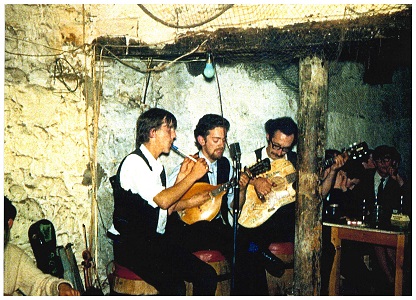“IT WAS IN THE AIR”

by Tom Kenny
Prior to 1961, public performance of Irish Traditional music in Galway took place primarily in the form of Céilís in large dancehalls – namely in the Hangar, the Commercial and the Astaire. These were enormously popular – remember the hundreds of bicycles parked outside the Hangar on a Sunday night – but they began to go out of fashion in the sixties and were regarded as old fashioned and backward.
Singing and music in pubs was generally frowned on and if you sang, you were likely to be thrown out. There were two exceptions to this, Cullen’s Bar in Forster Street and the Eagle Bar at the corner of William Street West and Henry Street. The owners, Martin Forde and Larry Cullen had an affinity with traditional music and musicians, but the sessions were intermittent and semi-private. In the Eagle, the recently formed (1956) branch of Comhaltas Ceoltóirí met and the Loch Lurgan Céilí Band used to rehearse.
In December 1961, Dick Byrne convinced his pal, Joe Hegarty of the Enda Hotel, of the possibility of hosting a music session there. He played the first night on his own, but it was a big success and soon he was joined by other musicians and the sessions became regular and popular. Dick and Joe and a few friends converted an old carriage house behind the hotel into a dedicated venue, The Fo’Castle Folk Club. It opened in 1963 and became nationally important as a venue. Festy Conlon and May Standún from Spiddal were regular performers and among the visitors who played there were the Dubliners, The Clancy Brothers, Paul Simon and Ramblin’ Jack Elliott. Three years later, Seán Tyrrell and his fellow students, Jack Geary, Seán Conroy and Johnny Mulhern took over the gig from Dick.
The club became a stepping stone for the emergence of a number of important groups and musical careers. One of those was Sweeney’s Men comprised of local man Joe Dolan, Andy Irvine and Johnny Moynihan who ‘helped define a new identity and pride for traditional music and had a major influence on the make-up of future groups such as Planxty, De Danann and the Bothy Band’.

Galway’s first regular traditional music session in a pub grew out of the Comhaltas meetings in the Eagle Bar. Pádraig Ó Carra was the founder and he was joined by Eamonn and Martin Rabbitte on fiddle and banjo, Dick Byrne as singer, Jimmy Cummins was on accordion and Eddie Maloney’s tin whistle playing was often the highlight.
The first Galway pub that had regular sessions at which the musicians were paid was O’Reilly’s in Forster Street. Eddie Maloney played at the first gigs as did Vincent Keegan on accordion and a teenage Frankie Gavin on piano. The music initially took place in the front bar but as they drew big crowds, they moved into the larger back section of the pub. The overflow from O’Reilly’s rekindled music in Cullen’s Bar across the street. Mrs. Cullen became a kind of patron of the arts in creating an atmosphere of celebration of music and culture, of socialising, transmission and sharing.
In the 1970s, the Cellar on Eglinton Street became another thriving live music pub. Out of sessions here, Mickey Finn, a fiddle player with an innovative style teamed up with Terry Smith, a guitar player and singer from Dublin and also a flute player from Roscommon named Mick Treacy to form a very exciting band named Dickler Fitz. Alec Finn and Frankie Gavin joined them before going on to form their own ground-breaking group called De Danann. Frankie Gavin, Alec Finn, Charlie Piggott and Johnny ‘Ringo’ McDonagh’s first public performance was as Ceoltóirí UCG (they later changed the name to De Danann) when they played in the Aula Maxima in College together with Ceoltóirí Laighean. The concert was organised by a student named Ollie Jennings who, because of his enjoyment of traditional music in Galway, started putting on gigs in the city which eventually, in 1978, became the Galway Arts Festival.
Between 1960 and 1979, traditional music making in Galway experienced major changes. The 1960s saw the emergence of a session scene which thrived here in the 1970s and transitioned from a semi-private non-commercial scene to regular co-existing commercial & non-commercial sessions. This atmosphere enabled the transmission, revitalisation and popularisation of Irish traditional music on a local level. It provided a creative space that facilitated musical innovation. Irish traditional music making was a major factor in Galway’s development into a cultural city.
All of the above is taken from a wonderful article written by Anna Falkenau in an impressive new book entitled “Hardiman and Beyond, The Arts & Culture of Galway since 1820” edited by John Cunningham and Ciaran McDonough and published by Arden Publishing. It is a series of explorations and reflections on cultural and artistic endeavour since 1820, the work of 50 writers and oral informants. It is profusely illustrated as our photographs show; the first is of Sweeney’s Men taken in the Fo’Castle in Dominick Street in 1966, the second is of the above-mentioned Terry Smith and Mickey Finn and dates from 1976. The book is priced at 45 euro, is available in good bookshops and is very highly recommended.
